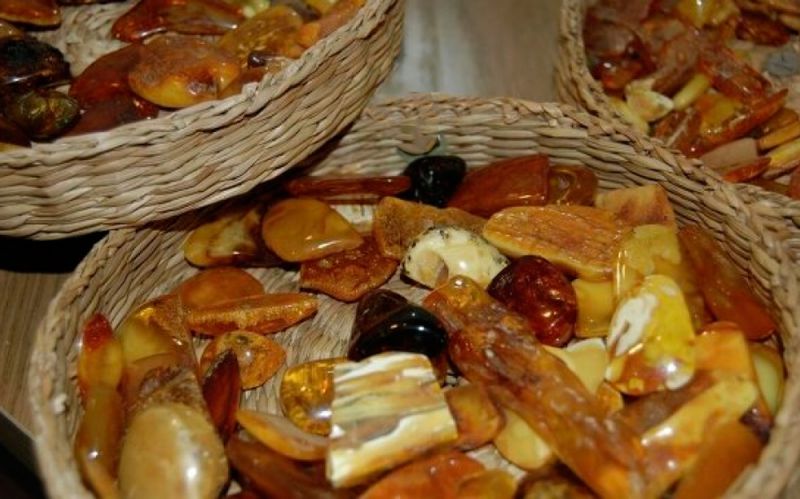Ukrainian amber
In Ukraine, amber has been known for a long time. Its primary developments are known near Kyiv (Mizhhirya and Vyshhorod region) and in Volyn (near modern Klesiv). In 1870, near Kyiv, 50 pieces of gems of different sizes weighing more than 800 g were found in one layer (this was reported by A.S. Rogovich in 1875).
Amber was washed by the Dnieper and other rivers during floods, and carried away by meltwater and rainwater from streams and ravines. In ancient times, its extraction not only satisfied local demand, but also made it possible to export it to ancient countries along the shores of the Mediterranean Sea and to eastern states. In 1843, the "Journal of the Ministry of Internal Affairs" wrote the following about this matter: Berislav is located at the confluence of the Samara and the Dnieper, and there is evidence that there was an ancient Greek settlement here. But even before the Greeks, the Phoenicians were the first to start trading amber, having relations with the Northern Black Sea region. Wasn't that where they got their first taste of amber before reaching the remote Kurish Gulf? - asks the author. Discover exquisite collections and genuine amber products at ukrburshtyn.com.
A famous Russian historian and archaeologist of the early 20th century. I. E. Zabelin noted that the ancient Greeks had reliable information about the extraction of amber from the earth - in Scythia, in Kyiv and its surroundings. And about Kiev amber, he believes, there could be stories that it was brought from the shores of the North Sea-ocean.
The ancient Roman historian Pliny the Elder wrote at the beginning of our era that in Scythia, amber is mined in two places: in one place it is white, the color of wax, in the other - yellow. The surface workings of small Kyiv deposits accessible to miners were gradually developed, neglected and forgotten.
Small deposits of amber have long been known in the western regions of Ukraine on the territory of the present Lviv and Ivano-Frankivsk regions. Red amber was found in the deposits of Lviv and its surroundings as early as the middle of the last century. The stone was not only mined along the Dnieper and its tributaries, in Volyn and Transcarpathia, but also processed in these places.
The color palette of Ukrainian amber is quite rich: in addition to yellow, there are white, honey-red, red, orange and dark cherry and rare green amber.
Kyiv amber was not inferior in composition and properties to Baltic amber (succinite). That is why it was sometimes called Kyiv succinite. Currently, amber is found on Neogene (Miocene) sediments covering sulfur ores in the Yaziv, Nemyriv, Rozdil and Podorozhnen deposits. More than 2,000 pieces of gems ranging in size from a millimeter to 25 cm and weighing from a few milligrams to one and a half kilograms have been counted in the quarry of the Yaziv deposit. Colorless, yellowish-white, yellow, brown-yellow, light and yellow-brown, transparent, translucent and opaque gem colors. A change in the degree of transparency of the stone along the section was observed. Transparent gems are concentrated in its middle.
The only Klesiv amber deposit in Ukraine is associated with Paleogene sediments. According to Ukrainian geologist V. I. Panchenko, it is located in the zone of Proterozoic crystalline rocks of the northwestern part of the Ukrainian Shield surrounded by Paleogene sedimentary formations. The placer consists of several sections, two of which were opened by quarries 472 and 43 (Velikiy Pugach). This site is located 1 - 4 km northwest of the Klesiv station. The productive horizon of the deposit consists of three sand layers composed of different-grained quartz sands, which are not equally enriched in clay, organic material and amber. The lower layer is sporadically enriched with glauconite, so the rock containing amber acquires a blue tint. Pieces of amber reach a size of 10 cm. According to V. I. Panchenko and A. S. Tkachuk, the amber content in the deposit is from 15 to 310, and even 1000 g/m3, the average is 50 g/m3.
Unlike the Baltic amber, Klesivskyi is much further away from the sea. It can be assumed that in Paleogene times there was a seashore not far from the village. The position of the ancient coastline in Volyn is also recorded by other finds of amber in this area. It is known that vertical tectonic movements of the earth's crust took place at the border of the Eocene and Oligocene, which led to the transgression (advancement) and regression (retreat) of the sea.
The German researcher F. Kaunhoven established that in the Tertiary period on the territory of the current Kaliningrad Peninsula, the interpenetration of sea and land changed 19 times. In the post-Oligocene period, amber deposits were exposed to denudation factors, it was carried by water into the latest deposits.

During the Ice Age in the south of the Baltic region, part of the deposits were separated from the main deposit and moved by the glacier. Glacial waters and the sea carried pieces of rock with amber to different countries of Europe. The outcrops of such rocks coincide with the boundary of glacial deposits lying on the border of Tertiary and Quaternary deposits. The presence of small amber clusters in Poland and Germany is connected with this process. Rocks containing amber on the underwater slope of the Kaliningrad Peninsula are still exposed to the active action of sea waves. Significant amounts of amber are washed up on beaches along much of the southern Baltic Sea coast. Coastal currents often carry washed-out stone to considerable distances from its original location.
Researchers claim that amber finds on the territory of Belarus are connected with fluvioglacial, lake-marsh, and coastal-sea sediments of the Cenozoic age. According to the combination of paleotectonic, facies-paleogeographical data and test results, two amber-rich areas can be distinguished in Belarus: Poliska, which decorates the Lukuv-Ratniv uplift and the northwestern slopes of the Ukrainian shield from the north, and Mikashevichsko-Zhytkovychska, confined to the slopes of the horst of the same name, etc. Amber is found in Paleogene quartz-glauconite sands in the form of pieces and their fragments with a size of 0.25-9 mm, rarely up to 7 cm (even up to 20 cm). In Quaternary sediments there are fist-sized pieces. Paleogene amber is located at significant (30-70 m) depths, Quaternary amber lies 6-15 m from the surface. The maximum concentrations of amber (up to PO g/m3) were recorded in the sediments of the Kyiv stage (Middle Paleogene) in the Poliska basin. Within the Mikashevich-Zhytkovitch region, the gem content is lower; the maximum concentrations (up to 33 g/m3) were noted in the quartz-glauconite sands of the upper part of the Kyiv layer.






